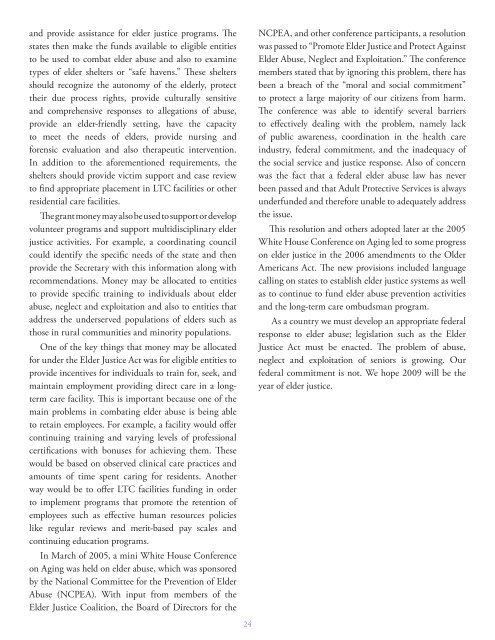elder abuse: a women's issue - OWL-National Older Women's League
elder abuse: a women's issue - OWL-National Older Women's League
elder abuse: a women's issue - OWL-National Older Women's League
You also want an ePaper? Increase the reach of your titles
YUMPU automatically turns print PDFs into web optimized ePapers that Google loves.
and provide assistance for <strong>elder</strong> justice programs. Thestates then make the funds available to eligible entitiesto be used to combat <strong>elder</strong> <strong>abuse</strong> and also to examinetypes of <strong>elder</strong> shelters or “safe havens.” These sheltersshould recognize the autonomy of the <strong>elder</strong>ly, protecttheir due process rights, provide culturally sensitiveand comprehensive responses to allegations of <strong>abuse</strong>,provide an <strong>elder</strong>-friendly setting, have the capacityto meet the needs of <strong>elder</strong>s, provide nursing andforensic evaluation and also therapeutic intervention.In addition to the aforementioned requirements, theshelters should provide victim support and case reviewto find appropriate placement in LTC facilities or otherresidential care facilities.The grant money may also be used to support or developvolunteer programs and support multidisciplinary <strong>elder</strong>justice activities. For example, a coordinating councilcould identify the specific needs of the state and thenprovide the Secretary with this information along withrecommendations. Money may be allocated to entitiesto provide specific training to individuals about <strong>elder</strong><strong>abuse</strong>, neglect and exploitation and also to entities thataddress the underserved populations of <strong>elder</strong>s such asthose in rural communities and minority populations.One of the key things that money may be allocatedfor under the Elder Justice Act was for eligible entities toprovide incentives for individuals to train for, seek, andmaintain employment providing direct care in a longtermcare facility. This is important because one of themain problems in combating <strong>elder</strong> <strong>abuse</strong> is being ableto retain employees. For example, a facility would offercontinuing training and varying levels of professionalcertifications with bonuses for achieving them. Thesewould be based on observed clinical care practices andamounts of time spent caring for residents. Anotherway would be to offer LTC facilities funding in orderto implement programs that promote the retention ofemployees such as effective human resources policieslike regular reviews and merit-based pay scales andcontinuing education programs.In March of 2005, a mini White House Conferenceon Aging was held on <strong>elder</strong> <strong>abuse</strong>, which was sponsoredby the <strong>National</strong> Committee for the Prevention of ElderAbuse (NCPEA). With input from members of theElder Justice Coalition, the Board of Directors for theNCPEA, and other conference participants, a resolutionwas passed to “Promote Elder Justice and Protect AgainstElder Abuse, Neglect and Exploitation.” The conferencemembers stated that by ignoring this problem, there hasbeen a breach of the “moral and social commitment”to protect a large majority of our citizens from harm.The conference was able to identify several barriersto effectively dealing with the problem, namely lackof public awareness, coordination in the health careindustry, federal commitment, and the inadequacy ofthe social service and justice response. Also of concernwas the fact that a federal <strong>elder</strong> <strong>abuse</strong> law has neverbeen passed and that Adult Protective Services is alwaysunderfunded and therefore unable to adequately addressthe <strong>issue</strong>.This resolution and others adopted later at the 2005White House Conference on Aging led to some progresson <strong>elder</strong> justice in the 2006 amendments to the <strong>Older</strong>Americans Act. The new provisions included languagecalling on states to establish <strong>elder</strong> justice systems as wellas to continue to fund <strong>elder</strong> <strong>abuse</strong> prevention activitiesand the long-term care ombudsman program.As a country we must develop an appropriate federalresponse to <strong>elder</strong> <strong>abuse</strong>; legislation such as the ElderJustice Act must be enacted. The problem of <strong>abuse</strong>,neglect and exploitation of seniors is growing. Ourfederal commitment is not. We hope 2009 will be theyear of <strong>elder</strong> justice.24



